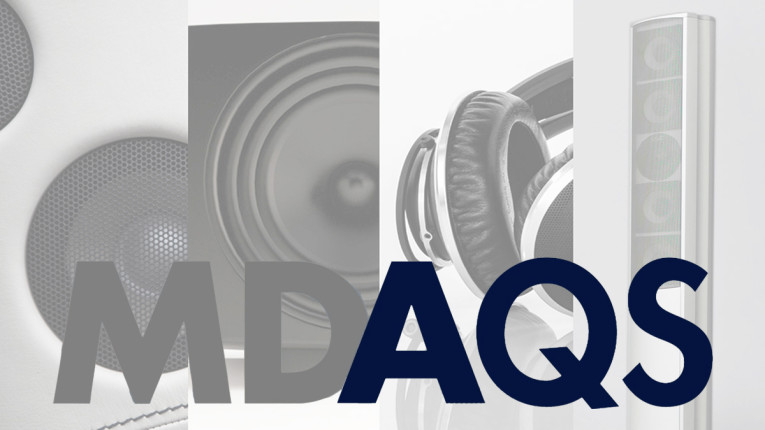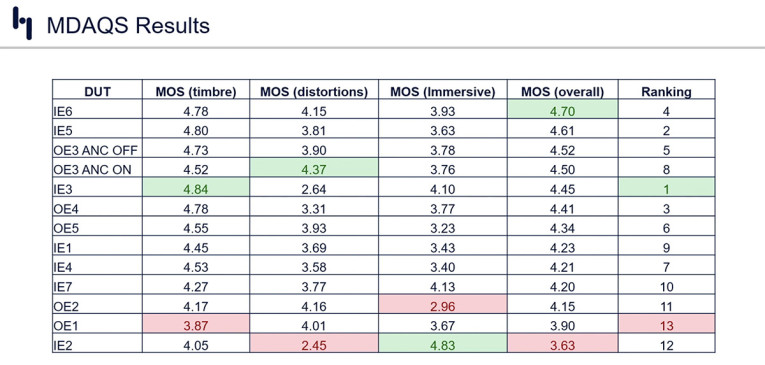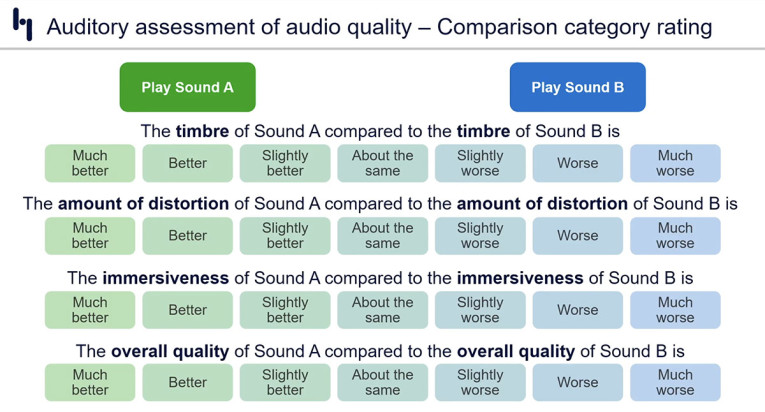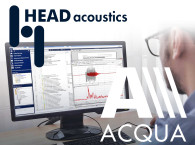
The novel method, according to HEAD acoustics, could be instrumental for audio device development and control/adjustment of audio quality, comprising the key criteria for human-based, perceived audio playback quality – timbre, distortion, immersiveness – along with an overall mean opinion score (MOS) value to allow for quick assessment and good comparability.
HEAD acoustics calls MDAQS, a milestone in instrumental audio quality assessment, and that's precisely what it means, given that it is the result of extensive efforts by the German test and measurement company, working in close cooperation with some of the largest global organizations in the telecom, consumer electronics, scientific research, and manufacturing sectors. In its applicability, it is effectively a world's first, that could offer the foundation for a much needed audio industry standard.
The proposal of a practical method for perceived assessment of audio playback quality, could help to consolidate a lot of existing research in the quantification of subjective assessments, gradings and rankings that have been established — some merely based on subjective opinions and inconsistent measurements, promoted in group forums and user communities, others based on extensive scientific research that generated more valid insights regarding consumer preferences, but doesn't provide applicable methods for the development process. In that regard, HEAD acoustics' MDAQS proposes the most comprehensive approach so far implemented, with clear benefits for the industry.
The quantification method for perception-based audio quality evaluation uses advanced metrics recreating human perception and replaces the need to introduce further human evaluation stages in the audio device development process. Particularly because the size of sample, environmental conditions, and many other factors always introduced undesired viability in the results of those efforts. With MDAQS, HEAD acoustics offers more reliable and meaningful audio quality testing results that are essential to speed up the development process.
MDAQS runs as an option in the ACQUA test software, the powerful speech and audio quality measurement and analysis software from HEAD acoustics. Integrated in its existing measurement process, it allows manufacturers to quickly and efficiently evaluate the audio quality of all types of playback devices, such as speakers, headphones, smart speakers, headsets, etc., in a scientific and quantifiable way.

"MDAQS builds on the extensive research into human perception and hearing models that HEAD acoustics has been working on since the company's beginnings, including modeling binaural processing and signal processing in the human ear," the company explains. "HEAD acoustics has conducted numerous intensive listening tests with carefully selected, untrained listeners. These "naïve" listeners have evaluated a variety of different audio devices with music of various genres based on several parameters. The results of these extensive listening tests serve as the basis for developing the algorithms and the training of MDAQS."
Detailing how this perception-based assessment was validated, HEAD acoustics conducted analysis and validation of the results, determining that the perception of the sound quality by normal users primarily depends on three quality dimensions: Timbre (resulting from the frequency response), Distortion, and the novel notion of "Immersiveness" which is increasingly used, but many previous research efforts have characterized using different words (stage, stereo image, spatial impression, acoustic image, etc - this was addressed in Recommendation ITU-R BS.1284-2 , AES recommended practices, and many other documents in different forums)
As HEAD acoustics describes, for MDAQS, Timbre defines how faithfully the spectrum and temporal precision of the signal stays intact; distortion describes how "clean" does it sound; and "Immersiveness", how well defined are the virtual sound sources in the room. And the criteria was also defined from the use of binaural recordings - the best equivalent of real human perception and realistic acoustics - as input for the analysis.
"These quality dimensions are sufficient to describe the overall audio quality. The MDAQS model will also be able to be refined with additional parameters depending on the application area. All parameters included by MDAQS provide a reliable, meaningful, and comparable overall assessment of audio quality," the company states.
Explaining a bit more about the process available to implemented MDAQS, HEAD acoustics uses binaural recordings in combination with the company's latest series of low-noise artificial heads (HMS), combined with the modular labCORE hardware interface, creating the ideal conditions for both sound recording and perfectly reproducing acoustic reality.
MDAQS uses this signal to calculate Mean Opinion Scores (MOS) for the perception-independent quality dimensions timbre (MOST), distortion (MOSD), and immersiveness (MOSI) and combines these values into an overall quality score. Therefore, this model can also be used to benchmark devices in an effortless and meaningful way. The images below illustrate MDAQS evaluation examples for headphones and earphones, including a grading of the overall MOS quality results.


The combination of HEAD acoustics' ACQUA software and MDAQS, together with labCORE and an artificial head such as the HMS II.3, can easily replace previously used measurement hardware and software solutions. "The interaction of the faithfully recorded sound signal and the unique MDAQS metrics models human perception so well that time-consuming and cost-intensive tests with test subjects become obsolete," the company adds.
HEAD acoustics GmbH is one of the world's leading sound and vibration analysis solutions provider, enjoying global recognition in the telecom sector due to its expertise and pioneering role in developing hardware and software for optimization of voice and audio quality. But, beyond the equipment and solutions, HEAD acoustics also provides a range of services to support engineering for technical products, investigation of environmental noise, speech quality engineering, consulting, training, and support. The company is headquartered in Herzogenrath, near Aachen, in Germany, and has subsidiaries in China, France, Italy, Japan, South Korea, the UK, the USA, and numerous sales partners worldwide.
www.head-acoustics.com








